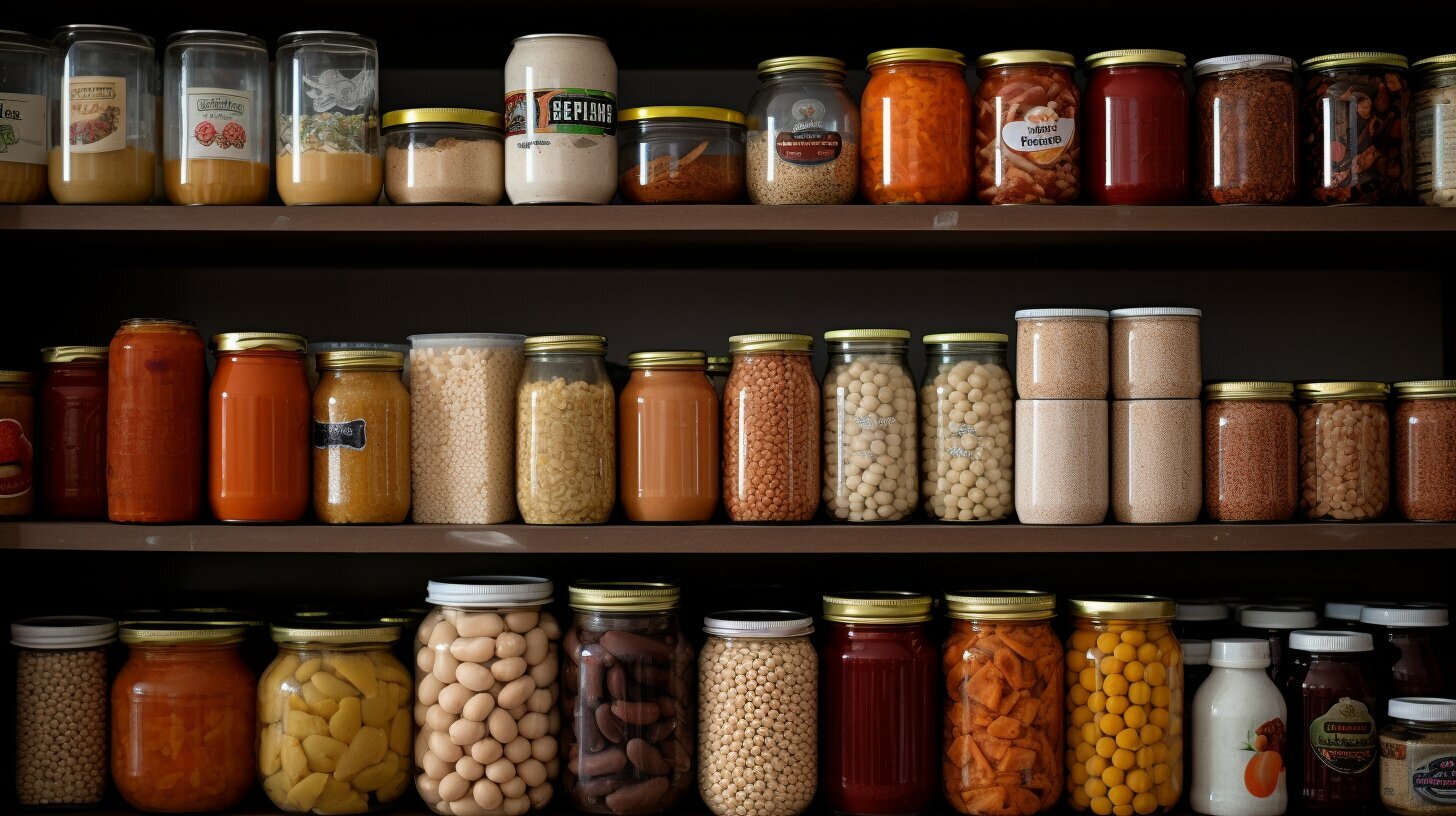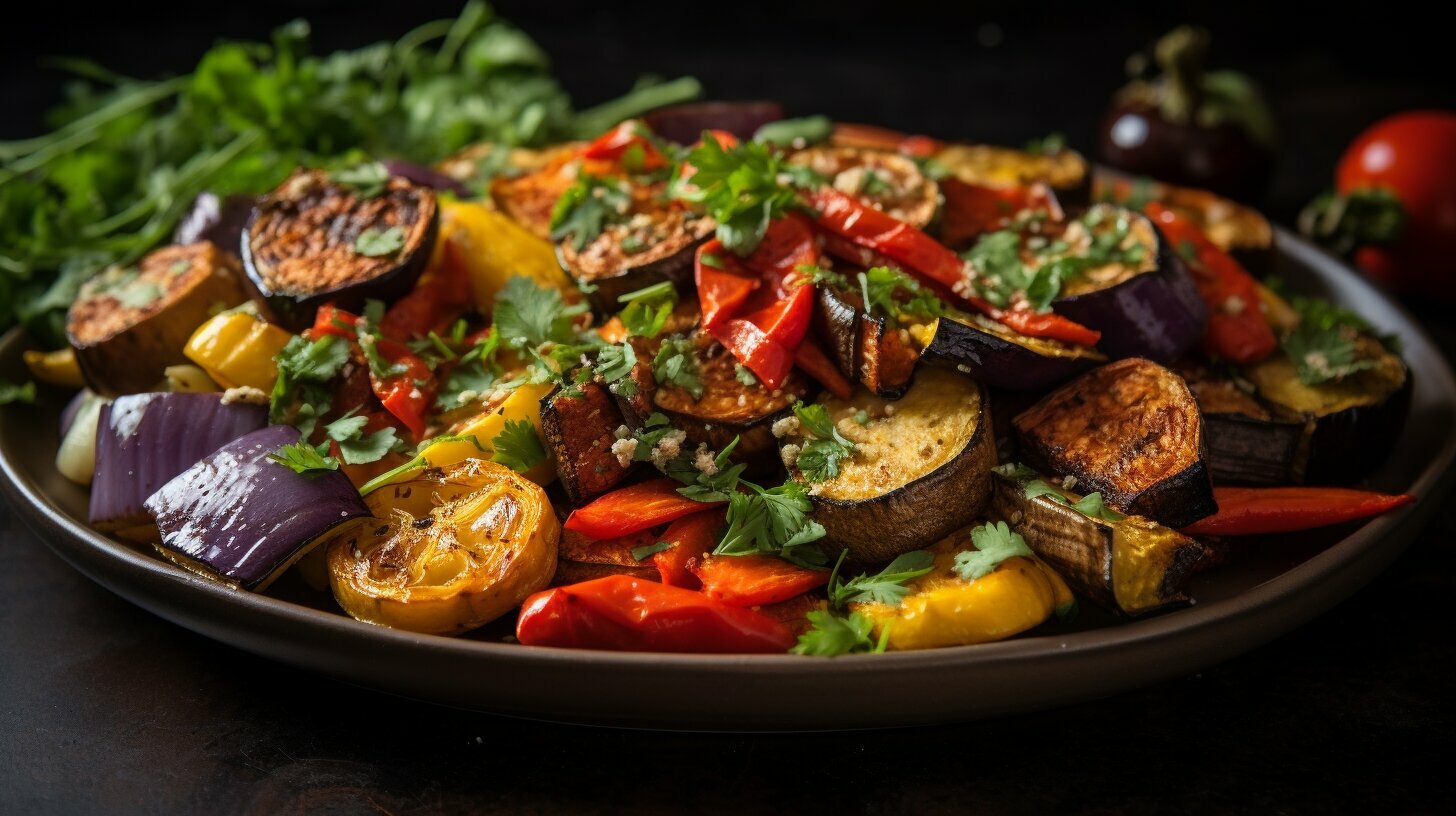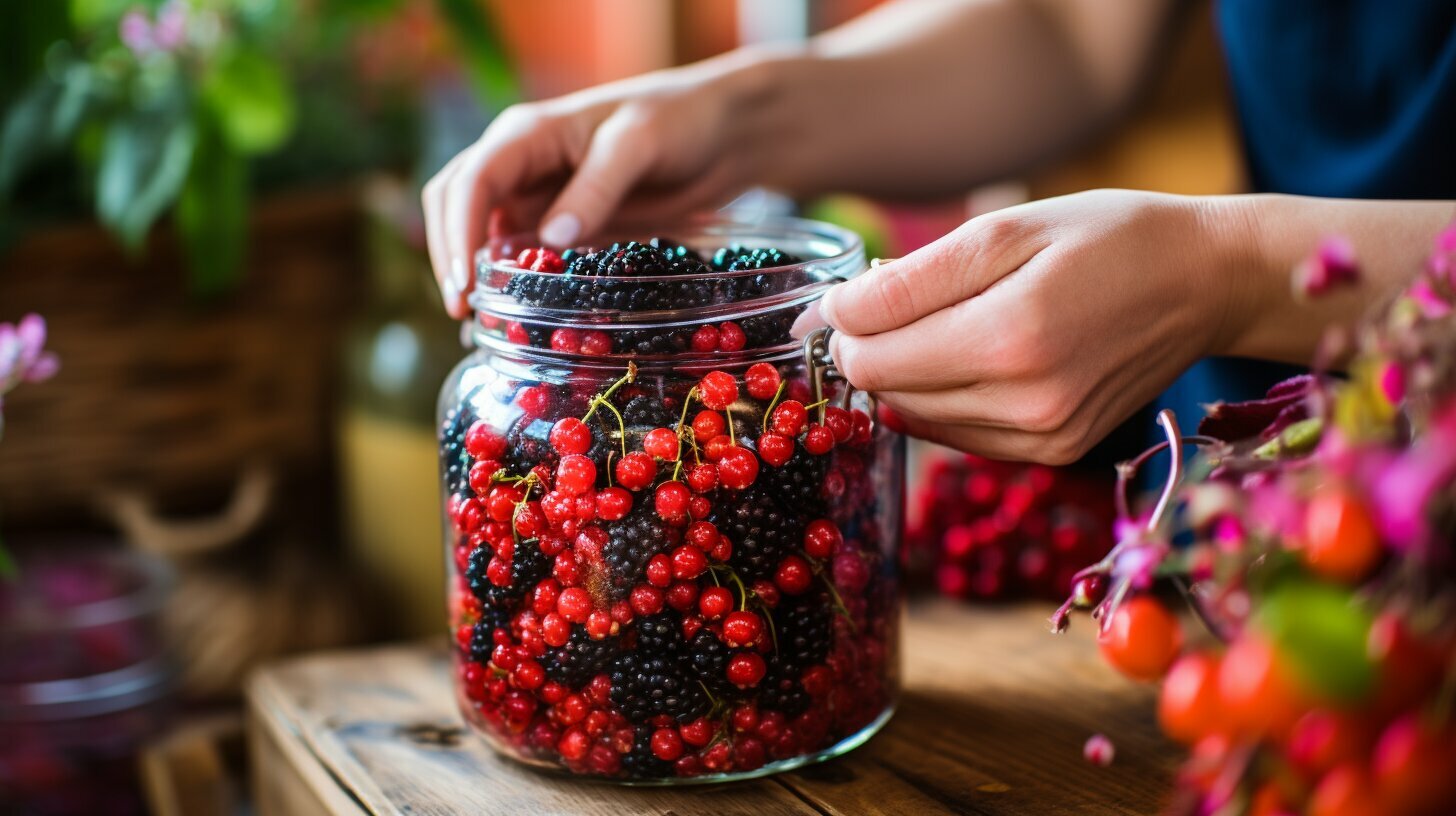As a journalist and a preparedness enthusiast, I cannot stress enough the importance of having a long term food storage plan in place. Emergencies can happen at any time, and having essential items stocked up can provide peace of mind and ensure the availability of fresh, nutritious food for you and your family.
In this article, I will provide a comprehensive list of items needed to start a long term food storage. From assessing your food storage needs to choosing the right containers, and stocking up on bulk foods, I will cover everything you need to know to build a long term food storage plan that works for you.
Disclosure: When you buy through links on our site, we may earn an affiliate commission.
Key Takeaways
- Having a long term food storage plan is essential for being prepared for emergencies.
- Assess your food storage needs before making any purchases.
- The right food storage containers are essential for maintaining the quality and longevity of your stored food.
- Buying food in bulk can save you money and ensure a constant supply of fresh food.
- Essential food storage supplies include Mylar bags, oxygen absorbers, canning jars, vacuum sealers, and measuring tools.
- Implementing rotation systems is crucial for maintaining the freshness and usability of stored food.
- Non-perishable foods and essential cooking and food preparation items should also be included in your long term food storage plan.
- A water storage system is necessary for emergency food storage.
- Creating a comprehensive food storage plan and regularly maintaining and updating it is essential.
Determining Your Food Storage Needs
Before you start buying long term food storage items, it’s important to determine your specific needs. Here are some factors to consider:
- The number of people in your household: This will determine the amount of food you need to store.
- Dietary restrictions: Take into account if anyone in your family has specific dietary restrictions or food allergies.
- Potential emergency scenarios: Consider the types of emergencies that could happen in your area and plan accordingly. For example, if you live in an area prone to hurricanes, you might need to prepare for power outages.
When it comes to food preservation methods, there are a few options for long term storage:
- Canning: This method is great for preserving fruits and vegetables, as well as meats. Canning involves boiling food in jars and sealing them tightly.
- Dehydrating: Dehydrating involves removing all the moisture from food. This method is great for long term storage of fruits, vegetables, and even meats.
- Freezing: Freezing food is a good option for short term storage, but it’s not the best for long term storage. Power outages or freezer failures can cause food to spoil.
Calculating the amount of food you need for your storage can be difficult, but it’s important to do so. A good rule of thumb is to plan for one to two pounds of food per person per day. You can use this as a starting point and adjust based on your specific needs.
Creating a Food Storage Inventory
One way to keep track of your food storage needs is to create an inventory. This can help you determine what items you need to buy and when. Keep a list of the expiration dates of your stored food, and be sure to rotate your stock to ensure freshness.
By taking the time to determine your food storage needs, you can ensure that you have enough food in case of an emergency. It’s also important to remember that your needs may change over time, so be sure to regularly reassess and update your food storage plan.
Choosing the Right Food Storage Containers
Proper food storage containers are essential for long term food storage. When selecting containers, look for those that are airtight and moisture-proof to prevent spoilage and contamination. Here are the types of containers available:
| Type of Container | Pros | Cons |
|---|---|---|
| Plastic | Lightweight, inexpensive, and easy to find. Some are stackable and have snap-on lids. | May leach chemicals into food over time. Can crack or break easily when exposed to extreme temperatures or rough handling. |
| Glass | Sturdy, non-toxic, and doesn’t absorb food odors. Some are oven-safe and can be used for cooking and serving food. | Heavy and not as portable as plastic or metal containers. Can break or shatter easily when dropped or exposed to extreme temperatures. |
| Metal | Durable, can withstand extreme temperatures, and doesn’t absorb food odors. Some are stackable and have tight-fitting lids. | Can rust or corrode when exposed to moisture or acidic foods. Not suitable for acidic or alkaline foods, which can react with the metal. |
It’s important to organize and label your food storage containers for easy access and rotation. You can use a marker or label maker to clearly identify the contents and expiration dates of each container. Keep your containers in a cool, dry, and dark place away from direct sunlight, heat sources, and pests.
Stocking Up on Bulk Foods
Buying food items in bulk is a great way to save money and ensure a long-lasting food supply. However, it’s important to properly store bulk foods to maintain their quality and avoid spoilage. Here are some tips on how to stock up on bulk foods:
- Choose a variety of bulk food options, such as grains, beans, pasta, and dried fruits.
- Consider buying from local farmers’ markets, online suppliers, or warehouse stores for the best deals.
- Make sure to properly store bulk foods in airtight containers and in a cool, dry place away from direct sunlight.
- Label containers with the date of purchase and the expiration date to ensure rotation and freshness.
- Be mindful of the shelf life of different types of bulk foods and rotate accordingly.

By following these tips, you can create a well-stocked and long-lasting food supply for your emergency preparedness needs.
Essential Food Storage Supplies
When it comes to long term food storage, having the right supplies is just as important as having the right food. These supplies help to ensure the longevity and quality of your stored food, and make it easier to organize and access your items. Here are some essential food storage supplies you should consider:
| Supply | Purpose |
|---|---|
| Mylar bags | Provide an airtight and moisture-proof barrier for food storage. |
| Oxygen absorbers | Remove oxygen from food storage containers to prevent spoilage and extend shelf life. |
| Canning jars | Provide airtight and secure storage for canned goods, dried herbs, and other food items. |
| Vacuum sealers | Remove air from food storage bags to create a tight seal and prevent spoilage. |
| Measuring tools | Ensure accurate portioning and measurement of food items for storage and preparation. |
These supplies can be purchased online or in stores specializing in food storage and preservation. It’s important to follow the instructions provided with each supply for proper usage and storage. With these essential food storage supplies, you can store your food with peace of mind and ensure its longevity.
Implementing Rotation Systems
Rotating your long term food storage is crucial for ensuring the freshness and usability of stored food. There are different rotation systems you can implement to prevent waste and maintain a constant supply of fresh food.
FIFO (First In, First Out)
This method involves organizing your food storage in a way that ensures the oldest items are used first. When you add new items to your storage, put them at the back so that the older items are front and center. This way, you will be using items before they reach their expiration date and preventing waste.
FEFO (First Expired, First Out)
This method involves organizing your food storage in a way that ensures the items closest to their expiration date are used first. When you conduct your regular inspections, check the expiration dates of all items in your storage. Use the items closest to their expiration date first, and replace them with fresh items.
Whichever rotation system you choose, it’s important to keep track of expiration dates and regularly inspect your food storage for signs of spoilage or pests. By implementing a proper rotation system, you can ensure the freshness and quality of your stored food, and avoid waste.
Sourcing Non-Perishable Foods
When it comes to building a long term food storage, including non-perishable items is crucial. These foods have a longer shelf life and can stay fresh for months or even years. Here are some important things to consider when sourcing non-perishable foods:
Types of Non-Perishable Foods
There are many options for non-perishable foods, including canned goods, freeze-dried meals, and dehydrated foods. When selecting non-perishable foods, it’s important to read the labels carefully to ensure they meet your dietary needs and preferences. Look for products with a long shelf life and proper storage instructions.
Shelf Life of Non-Perishable Foods
Non-perishable foods can last for different lengths of time depending on the type of food and how it’s stored. Canned goods, for example, can last for years if stored in a cool, dry place. Freeze-dried and dehydrated foods can also have a long shelf life if stored properly. Be sure to check the expiration dates on all products and rotate your stock regularly to ensure freshness.
Proper Storage of Non-Perishable Foods
Storing non-perishable foods properly is crucial for maintaining their quality and shelf life. Keep them in a cool, dry place, away from direct sunlight and moisture. Use airtight containers or resealable bags to prevent air and moisture from getting in. Label each container with the date of purchase and the expiration date. Consider investing in a food vacuum sealer to remove excess air from food packaging to help extend their shelf life.
Where to Source Non-Perishable Foods
You can find non-perishable foods in grocery stores, online retailers, and specialty food stores. When purchasing items in bulk, consider contacting wholesale suppliers or manufacturers directly. Be sure to compare prices and check for sales to save money. Keep in mind that shipping costs can add up, so look for free shipping offers or consider buying from local sellers.
Including Essential Cooking and Food Preparation Items
When it comes to long term food storage, it’s not just about having enough food–you also need to have the tools to prepare and cook it. Here are some essential cooking and food preparation items to consider:
| Item | Description |
|---|---|
| Portable stove or grill | A small, lightweight stove or grill that can be used indoors or outdoors. |
| Cooking utensils | Include a can opener, pots and pans, and utensils such as spoons, spatulas, and tongs. |
| Water filtration system | A device that removes impurities from water, making it safe to drink. |
| Manual grain grinder | To grind grains and flour by hand, which can be necessary during extended power outages. |
When selecting cooking and food preparation items for long term food storage, consider choosing items that are multi-functional and space-saving. Choose high-quality items that are durable and can withstand frequent use.
Remember, having these essential cooking and food preparation items are just as important as storing food. Without them, your long term food storage may not be as useful as you hope.
Establishing a Water Storage System
Having access to clean and safe water is crucial for survival, especially during emergencies. It’s essential to include a water storage system in your long term food storage plan. Here are some options to consider:
| Option | Description |
|---|---|
| Water barrels | These are large containers specifically designed for storing water. They come in different sizes and materials, including plastic, metal, or fiberglass. Ensure that the barrels are food-grade and airtight to prevent contamination. It’s also crucial to rotate the water supply every six months. |
| Water purification tablets | These tablets kill bacteria and viruses and are a convenient option for emergency situations. They’re compact and lightweight, making them an excellent choice for outdoor activities or camping trips. |
| Water filtration systems | These systems use different technologies to remove impurities from water, making it safe for consumption. They come in various sizes and types, including straw filters, gravity filters, and pump filters. It’s crucial to follow the manufacturer’s instructions when using them. |
When calculating the quantity of water needed, consider storing at least one gallon of water per person per day for a minimum of three days. It’s also essential to store additional water for cooking and hygiene purposes.
Proper storage and rotation of water supplies are crucial to maintain their quality. Store water away from direct sunlight, heat sources, and chemicals, and rotate the water supply every six months. It’s also crucial to regularly inspect the water storage system for leaks or signs of damage.
Creating a Food Storage Plan
Now that you have assessed your food storage needs and acquired essential items, it’s time to create a comprehensive food storage plan. Your plan should take into account your budget, storage space, and personal preferences.
Start by determining the quantity of food you need for your storage. Use the tips provided in the previous section to calculate the quantity of food needed for each member of your household and for different emergency scenarios.
Next, create a rotating system for your food storage. Use the FIFO (First In, First Out) or FEFO (First Expired, First Out) method to ensure that the oldest food is used first and that fresh food is constantly rotated into your storage.
Keep track of expiration dates and regularly update your food storage inventory. Make sure to involve your family members in the planning process to ensure everyone is on the same page and knows how to access and use the stored food.
Finally, make sure to regularly review and update your food storage plan based on changing circumstances or dietary needs. Being proactive and prepared can bring peace of mind and make all the difference in an emergency situation.
Maintaining Your Long Term Food Storage
Regular maintenance of your long term food storage is crucial to ensure the longevity and freshness of your stored food. Here are some tips to help you stay on top of your food storage game:
- Conduct regular inspections: Check your storage area at least once a year to make sure that all containers are properly sealed, no signs of pests, and the food is still fresh.
- Check for spoilage: Open containers to check for any signs of spoilage such as mold, discoloration, or an off-smell. Discard any food that fails this test.
- Rotate regularly: Use a first in, first out (FIFO) or first to expire, first out (FEFO) system to rotate your food storage. This will help you use the oldest items first and prevent waste.
- Replace expired items: Check the expiration dates of your stored food regularly and replace any expired items immediately.
- Update your plan: Update your food storage plan regularly to reflect changes in your circumstances, such as new dietary restrictions, additional family members, or a move to a new location.
By following these simple steps, you can ensure that your long term food storage is always ready for any emergency that may arise.
Conclusion
Building a long term food storage may seem daunting, but it is a vital step towards preparedness for emergencies. By having essential items for starting your long term food storage, you can ensure that you and your family have access to fresh and nutritious food during times of need.
Remember to determine your food storage needs, choose the right food storage containers, stock up on bulk foods, and gather essential food storage supplies. Organization and proper rotation of your supplies are key to maintaining the quality of your food storage over time.
Don’t forget to include non-perishable foods, cooking and food preparation items, and establish a water storage system. Creating a comprehensive food storage plan and regularly maintaining and updating your supplies will ensure that you are always prepared for any situation.
So start building your long term food storage today. Your future self will thank you for being prepared!
FAQ
Q: What are the essential items for starting your long term food storage?
A: The essential items for starting your long term food storage include bulk food items, food storage containers, food storage supplies, non-perishable foods, cooking and food preparation items, a water storage system, and a comprehensive food storage plan.
Q: How do I determine my food storage needs?
A: To determine your food storage needs, consider factors such as the number of people in your household, dietary restrictions, and potential emergency scenarios. Calculate the quantity of food needed based on different food preservation methods suitable for long term storage.
Q: What should I look for in food storage containers?
A: When choosing food storage containers, look for airtight and moisture-proof options. Consider different types of containers available in the market, including plastic, glass, and metal. Organize and label your containers for easy access and rotation.
Q: Why should I stock up on bulk foods for long term storage?
A: Stocking up on bulk foods for long term storage offers advantages such as cost savings and convenience. Different types of bulk food options include grains, beans, pasta, and dried fruits. Make sure to properly store bulk foods to maintain their quality and shelf life.
Q: What are the essential food storage supplies I need?
A: Essential food storage supplies include Mylar bags, oxygen absorbers, canning jars, vacuum sealers, and measuring tools. Each supply serves a specific purpose in ensuring the longevity of your stored food. Purchase these supplies from reputable sources and use them correctly.
Q: How do I implement rotation systems in my food storage?
A: Implement rotation systems to ensure freshness and usability of stored food. Different rotation methods include FIFO (First In, First Out) and FEFO (First Expired, First Out). Organize and rotate your food storage to prevent waste and maintain a constant supply of fresh food.
Q: Where can I find non-perishable foods for long term storage?
A: You can find non-perishable foods for long term storage in various forms, such as canned goods, freeze-dried meals, and dehydrated foods. Read food labels and select high-quality options. Understand the shelf life of different non-perishable foods and store them properly.
Q: What cooking and food preparation items should I include in my long term food storage?
A: Include essential cooking and food preparation items in your long term food storage, such as a portable stove or grill, cooking utensils, can openers, and water filtration systems. Select compact and multi-functional items to optimize space.
Q: How can I establish a water storage system for my long term food storage?
A: Establish a water storage system by using options like water barrels, water purification tablets, or water filtration systems. Calculate the quantity of water needed, store and rotate water supplies properly to ensure safety and availability.
Q: How do I create a food storage plan?
A: Create a comprehensive food storage plan by considering factors like budget, storage space, and personal preferences. Develop a rotating system, track expiration dates, and regularly update your food storage inventory. Involve your family in the planning process for better preparedness.
Q: How do I maintain my long term food storage?
A: Regularly maintain and update your long term food storage by conducting inspections, checking for pests or signs of spoilage, and replacing expired items. Update your food storage plan based on changing circumstances or dietary needs.




